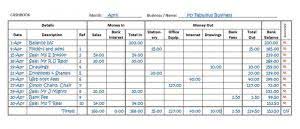Content
Profitability IndexThe profitability index shows the relationship between the company projects future cash flows and initial investment by calculating the ratio and analyzing the project viability. One plus dividing the present value of cash flows by initial investment is estimated. It is also known as the profit investment ratio as it analyses the project’s profit. Net income an asset is expected to generate divided by its average capital cost, expressed as an annual percentage. The ARR is a formula used to make capital budgeting decisions. It is used in situations where companies are deciding on whether or not to invest in an asset (a project, an acquisition, etc.) based on the future net earnings expected compared to the capital cost.
Return on Assets: Definition, Formula, Example – Business Insider
Return on Assets: Definition, Formula, Example.
Posted: Wed, 06 Jul 2022 07:00:00 GMT [source]
Both average return and ARR are commonly used methods of determining relative performance levels. Accept the project only if its ARR is equal to or greater than the required accounting rate of return. In case of mutually exclusive projects, accept the one with highest ARR. This might involve deciding which piece of equipment or machinery to buy, or whether to move to bigger premises. Any investment is made in the hope that in return the business will see its profits increase. The internal rate of return is a metric used in capital budgeting to estimate the return of potential investments.
Accounting Rate of Return
After that time, it will be at the end of its useful life and have $10,000 in salvage value. Then, to arrive at the final figure for annual net profit, simply subtract the depreciation expense from your annual revenue figure. Typically, ARR is used to make capital budgeting decisions. While solving the accounting rate of return example problems pdfs, you need to apply the average rate of return formula and put the figures in the right places. The calculator will let you know if you should make this investment or not. A return calculator gives you an idea about the investment you are making. If you see that the accounting rate of return decision rule is not supporting your investment then, you should not opt to invest such an investment.
Similarly, you can calculate the accounting rate of return ppt as well. So, whatever platform you choose to calculate the return on investment, the accounting rate of return calculator can help. All you need to do is to put the formula and mention exact values to get the exact value of return on your investment. If you make a comparison like ARR vs IRR then, you will find ARR more exact as IRR first takes the value to zero and then gives a decimal value. The ARR calculator created by iCalculator can be really useful for you to check the profitability of the past, present or future projects. It is also used to compare the success of multiple projects running in a company. Using ARR you get to know the average net income your asset is expected to generate.
How does this accounting rate of return calculator work?
If the ARR is equal to 5%, this means that the project is expected to earn five cents for every dollar invested per year. Net Present Value – This means the difference between the present value of cash inflow in any company and present value of cash outflow over a period of time. Calculations will satisfy the interest of a business owner and will result in getting more investors’ attention. After using the calculator you will know the net earnings after tax and depreciations, which is an important factor while appraising any project proposals. Final investment – The amount finally invested in the project. Therefore, the ARR of the real estate investment is 10.00%. Double Entry Bookkeeping is here to provide you with free online information to help you learn and understand bookkeeping and introductory accounting.
- It can help you understand your total profits very easily.
- Further, investors use this return for ranking the assets and eventually make the investment as per the ranking and include them in the portfolio.
- All you need to do is to put the formula and mention exact values to get the exact value of return on your investment.
- XYZ Company is considering investing in a project that requires an initial investment of $100,000 for some machinery.
Use the Average Rate of Return Calculator to calculate the percentage rate of return expected on an investment or asset as compared to the initial investment cost. By using the ARR calculator, you can get to know the return on investment that you are making. You can compare every aspect of your investment with the profit that you will be earning from this investment. People usually ask, how to calculate accounting rate of return in excel? Before answering that, you should know that this calculator can help you to decide if the project you are investing in is suitable for you or not.
Example of the Accounting Rate of Return (ARR)
EasyCalculation offers a simple tool for working out your ARR, although there are many different ARR calculators online to explore. If the investment is a fixed asset, such as property, you’ll need to work out the depreciation expense. Of course, that doesn’t mean too much on its own, so here’s how to put that into practice and actually work out the profitability of your investments. We are given annual revenue, which is $900,000, but we need to work out yearly expenses.
How to Calculate Return on Investment (ROI) – Investopedia
How to Calculate Return on Investment (ROI).
Posted: Sat, 25 Mar 2017 19:33:53 GMT [source]
To use the accounting rate of return calculator, you need to know the formula for ARR calculations. This calculator estimates the average annual return of an entire account based on the starting and ending balances as well as the dates and amounts of deposits or withdrawals. Do the Calculation the Avg rate of return of the investment based on the given information.
Benefits of using the ARR calculator
So for example, $45000 which we have received in year 2 will could have been less if the time value has been considered. Here we are not given annual revenue directly either directly yearly expenses and hence we shall calculate them per the below table. Salvage ValueSalvage value or scrap value is the estimated value of an asset after its useful life is over.
- Incremental expenses – It is defined as the main expenses that are going to be incurred while the project is running.
- The initial investment required to be made for this new project is 200,000.
- This can be helpful because net income is what many investors and lenders consider when selecting an investment or considering a loan.
- Instead, it focuses on the net operating income the investment will provide.
Financial terms and calculations includes revenue, costs, profits and loss, average rate of return, and break even. These financial elements inform key decisions in every business. In other words, two investments might yield uneven annual revenue streams. ARR is calculated as average annual profit / initial investment.
It can help you understand your total profits very easily. Number of years – This refers to the duration of the project, for the duration it is expected to run. If so, it would be great if you could leave a rating below, it helps us to identify which tools and guides need additional support and/or resource, thank you. For example, a small local building business has decided to invest in a small excavator, since it will allow jobs to be completed more quickly and therefore more work to be completed. Chartered accountant Michael Brown is the founder and CEO of Double Entry Bookkeeping. He has worked as an accountant and consultant for more than 25 years and has built financial models for all types of industries. He has been the CFO or controller of both small and medium sized companies and has run small businesses of his own.
In other words, it’s the amount of time it takes to get back the full investment and become profitable. Because most financial formulas revolve around and are presented in annualized figures, cumulative return as a metric is less commonly useful due to the lack of meaningful comparisons.
If you do spot a mistake in this https://online-accounting.net/, please let us know and we will try to fix it. Finally, divide the figure arrived in step 5 by the initial investment, and resultant would be an annual accounting rate of return for that project. As mentioned earlier, this calculator tells you about the investment you are making. You can use the accounting rate of return decision rule and excel sheets to know if the investment is right for you.
ARR for projections will give you an idea of how well your project has done or is going to do. Calculating the accounting rate of return conventionally is a tiring task so using a calculator is preferred to manual estimation. If you choose to complete manual calculations to calculate the ARR it is important to pay attention to detail and keep your calculations accurate. If your manual calculations go even the slightest bit wrong, your ARR calculation will be wrong and you may decide about an investment or loan based on the wrong information. Hence using a calculator helps you omit the possibility of error to almost zero and enable you to do quick and easy calculations.
Online Calculator
It is important that you have confidence if the financial calculations made so that your decision based on the financial data is appropriate. ICalculator helps you make an informed average accounting return calculator financial decision with the ARR online calculator. Payback Period or Discounted Payback Period – This refers to the time required to reach the break-even period on any investment.
The ARR can be used by businesses to make decisions on their capital investments. It can help a business define if it has enough cash, loans or assets to keep the day to day operations going or to improve/add facilities to eventually become more profitable. One calculation that can help a business to compare different investment options is the average rate of return . A rate of return is the gain or loss of an investment over a specified period of time, expressed as a percentage of the investment’s cost. Also, ARR does not take into account the impact of cash flow timing. Let’s say an investor is considering a five-year investment with an initial cash outlay of $50,000, but the investment doesn’t yield any revenue until the fourth and fifth years. ARR comes in handy when investors or managers need to quickly compare the return of a project without needing to consider the time frame or payment schedule but rather just the profitability or lack thereof.

